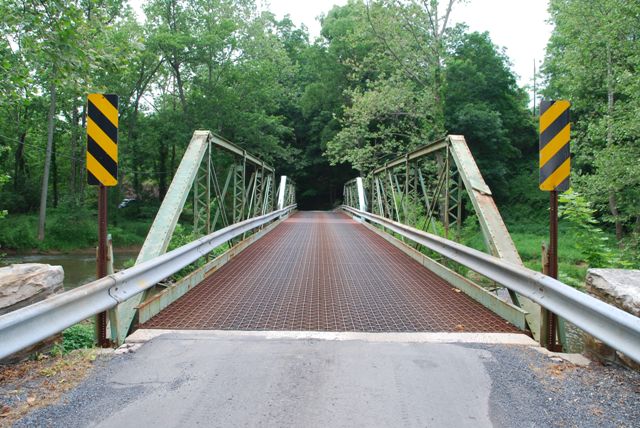We Recommend:
Bach Steel - Experts at historic truss bridge restoration.
BridgeHunter.com Phase 1 is released to the public! - Visit Now
Iron Bridge Road Bridge

Primary Photographer(s): Elaine Deutsch
Bridge Documented: June 11, 2011
Rural: Perry County, Pennsylvania: United States
1899 By Builder/Contractor: Pittsburgh Bridge Company of Pittsburgh, Pennsylvania, Nelson and Buchanan of Chambersburg, Pennsylvania Agents
1993
80.0 Feet (24.4 Meters)
162.0 Feet (49.4 Meters)
13.5 Feet (4.11 Meters)
2 Main Span(s)
50300900201815

View Information About HSR Ratings
Bridge Documentation
View Archived National Bridge Inventory Report - Has Additional Details and Evaluation
This bridge is a rare example of a multi-span pony truss bridge. Most pony truss bridges are single span or are approach spans for a bridge with a through truss main span. The bridge is also unusual for its bottom chord which is sloped at the end panels. Despite the alterations outlined by the Historic Bridge Inventory, the unusual features mentioned above should balance out the loss of significance from alteration and keep the bridge eligible for the National Register of Historic Places. The antiquated comment by the Historic Bridge Inventory that pin-connected truss bridges are common does not reflect the reality of today's world, where such bridges are uncommon and becoming rare.
Thanks to PennDOT, this bridge type is about to become rarer. The bridge was damaged by a vehicle that collided with the bridge and subsequently closed to traffic. Reportedly, the bridge was to be repaired.
Information and Findings From Pennsylvania's Historic Bridge InventoryDiscussion of Bridge The 2-span, 162'-long, pin-connected Pratt pony truss bridge, fabricated in 1899 by the Pittsburgh Bridge Co. and erected by their agents Nelson and Buchanan, is supported on a stone substructure. The trusses are traditionally composed of built-up compression members and eye bar tension members. In 1940, the rolled floorbeams were strengthened by angles welded to the flanges. In 1978 the timber stringers and deck were replaced by steel stringers and an open steel grid deck. In 1993 two end posts of the northern span were replaced with welded members and the lower chord members in the end panels replaced with metal bars. The bridge has loss of original fabric and is an example of the state's most common type of pin-connected truss bridge by one of the state's most prolific builders. Many more complete examples of similar age and design have been identified, including 28 3026 0010 1854 (1888, NR-listed) and 57 7407 0091 0001 (1898). The bridge is not historically distinguished by its setting or context. Discussion of Surrounding Area The bridge carries one lane of traffic over a stream in a rural setting of active farms and scattered 19th to late 20th century residences. Each of the bridge's quadrants is wooded. Bridge Considered Historic By Survey: No |
![]()
Photo Galleries and Videos: Iron Bridge Road Bridge
Bridge Photo-Documentation
Original / Full Size PhotosA collection of overview and detail photos. This gallery offers photos in the highest available resolution and file size in a touch-friendly popup viewer.
Alternatively, Browse Without Using Viewer
![]()
Bridge Photo-Documentation
Mobile Optimized PhotosA collection of overview and detail photos. This gallery features data-friendly, fast-loading photos in a touch-friendly popup viewer.
Alternatively, Browse Without Using Viewer
![]()
Maps and Links: Iron Bridge Road Bridge
Coordinates (Latitude, Longitude):
Search For Additional Bridge Listings:
Bridgehunter.com: View listed bridges within 0.5 miles (0.8 kilometers) of this bridge.
Bridgehunter.com: View listed bridges within 10 miles (16 kilometers) of this bridge.
Additional Maps:
Google Streetview (If Available)
GeoHack (Additional Links and Coordinates)
Apple Maps (Via DuckDuckGo Search)
Apple Maps (Apple devices only)
Android: Open Location In Your Map or GPS App
Flickr Gallery (Find Nearby Photos)
Wikimedia Commons (Find Nearby Photos)
Directions Via Sygic For Android
Directions Via Sygic For iOS and Android Dolphin Browser
USGS National Map (United States Only)
Historical USGS Topo Maps (United States Only)
Historic Aerials (United States Only)
CalTopo Maps (United States Only)

